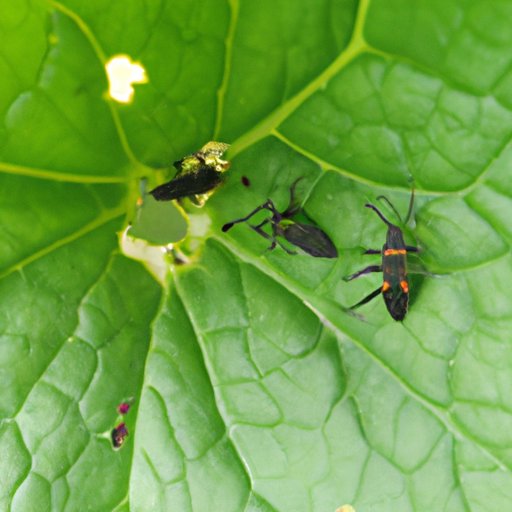
Introduction
Squash bugs are a common garden pest that can quickly destroy the hard work you put into growing your squash plants. These insects feed on the leaves, stems, and fruit of squash plants, causing wilting, stunted growth, and eventual death. Luckily, there are several methods for getting rid of squash bugs, both natural and chemical. In this article, we’ll explore these methods and provide tips for preventing a squash bug infestation before it starts.
Natural Methods
Natural methods for controlling squash bugs are a popular choice for gardeners who want to avoid using harsh chemicals. These methods are generally safe for people, pets, and the environment. Here are some natural methods you can try:
Companion Planting
Companion planting involves planting certain crops alongside squash to help naturally deter squash bugs. Some good companion plants for squash include marigolds, nasturtiums, and radishes. These plants have strong scents that can repel squash bugs, making them less likely to attack your squash plants. You can also try planting beneficial herbs like dill, fennel, or parsley, which attract beneficial insects that prey on squash bugs.
Introducing Beneficial Insects
If companion planting isn’t enough, you can also try introducing beneficial insects to your garden. Some good insects for controlling squash bugs are ladybugs, lacewings, and praying mantises. You can purchase these insects online or at your local garden store and release them into your garden. They will help keep the squash bug population in check by eating both the adults and the eggs.
Removing Eggs and Manually Squishing Bugs
One of the simplest ways to get rid of squash bugs is to remove their eggs and manually squish the bugs. Squash bug eggs are laid in clusters on the underside of leaves and are copper-colored. Simply scrape the eggs off the leaves and discard them in a container filled with soapy water. To manually squish the bugs, wear gloves and use your hands to crush the insects, being careful not to damage the plants.
Chemical Control
If natural methods aren’t effective in controlling squash bugs, or if the infestation is severe, you may need to resort to chemical control methods. Here are some things to keep in mind:
When and Why to Use Chemical Control
Chemical control methods should only be used as a last resort, as they can be harmful to people, pets, and the environment. However, if the infestation is severe and natural methods are not working, chemical control may be necessary. In addition, if you are growing organic squash, you will need to choose an organic insecticide that is approved for use in organic gardening.
Types of Insecticides
There are several types of insecticides that can effectively control squash bugs. Some common ones include pyrethrins, neem oil, and insecticidal soap. Look for insecticides that are labeled specifically for controlling squash bugs and follow the instructions carefully.
Safety Tips
Always read and follow the instructions on the label of the insecticide you choose. Wear gloves, protective clothing, and a face mask when handling and applying insecticides. Keep children and pets away from the treated area until the insecticide has dried.
Prevention
Preventing a squash bug infestation before it starts is key to keeping your squash plants healthy and productive. Here are some prevention tips:
Plant Resistant Varieties
Some varieties of squash are naturally more resistant to squash bugs than others. Look for varieties that are labeled as resistant to squash bugs, such as butternut or acorn squash.
Rotate Crops
Rotating your crops can help prevent squash bugs from becoming established in your garden. Avoid planting squash in the same spot every year, as this can lead to a buildup of pests and disease.
Keep Gardens Clean
Keeping your garden clean and free from debris can help prevent squash bugs and other pests from finding a home in your plants. Remove fallen leaves, weeds, and other debris from your garden regularly.
Traps
Traps can be a useful tool for getting rid of squash bugs. Here are some types of traps you can try:
Pheromone Traps
Pheromone traps are designed to lure squash bugs into a sticky trap using a synthetic version of the bug’s mating scent. These traps can be effective, but they may also attract other beneficial insects that you don’t want to catch.
Sticky Traps
Sticky traps are simple, inexpensive traps that use a sticky substance to catch squash bugs. You can make your own sticky traps using yellow index cards coated in petroleum jelly.
Board Traps
Board traps are made by placing a piece of wood or cardboard on the ground near your squash plants. Squash bugs will gather underneath the board at night, and you can simply discard the bugs in the morning.
Disease Control
Diseases can also help control squash bugs. Here are some tips:
Plant in Healthy Soil
Healthy soil will help your squash plants resist disease, which in turn makes them less attractive to squash bugs. Test your soil regularly and amend it with compost or other organic matter as needed.
Avoid Overwatering
Squash plants that are overwatered are more likely to develop diseases that can attract squash bugs. Water your squash plants deeply but infrequently, and avoid getting the leaves wet.
Expert Advice
If you’re still struggling to get rid of squash bugs, consider seeking advice from gardening experts. Many gardening websites and forums have experienced gardeners who can offer tips and advice on dealing with squash bugs.
Conclusion
Controlling squash bugs can feel like a never-ending battle, but by using a combination of natural and chemical methods, preventing an infestation, and using traps or disease control, you can keep your squash plants healthy and productive. Remember to always read and follow the instructions carefully when using insecticides, wear protective clothing when handling chemicals, and keep children and pets away from treated areas.




